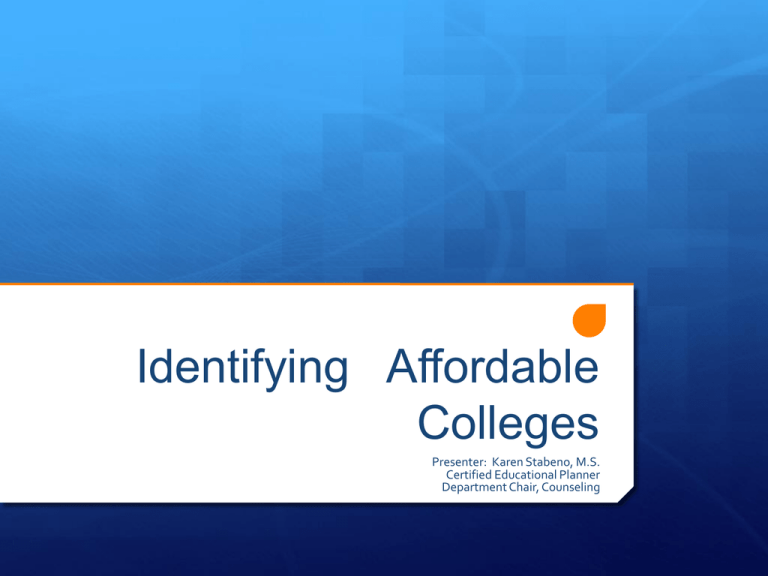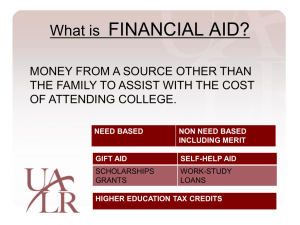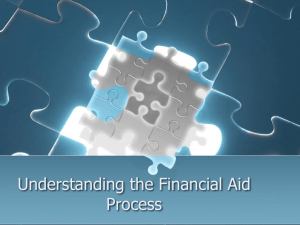Identifying Affordable Colleges
advertisement

Identifying Affordable Colleges Presenter: Karen Stabeno, M.S. Certified Educational Planner Department Chair, Counseling About this Presentation “Good Financial Aid planning is not necessarily good tax planning”. I am not a financial planner and I am not offering financial advice. The purpose of this presentation is to prepare families to become better consumers by teaching the vocabulary, timelines, and context of how financial aid is offered. What I will do is provide you with the tools to evaluate colleges to see which would be the most generous for your child. The Challenge College Tuition costs have Increased over the last 20 years 439% , medical care 251%, median family income 147%, consumer price index 106% What is Financial Aid? Financial Aid is awarded to families that meet the need-based requirements. A formula regulated by the Department of Education. Two Categories of Student Aid -Gifts (Scholarships and Grants) -Self-help (Loans and Campus Jobs) Types of Gift-Based Aid Institutional Scholarships & Grants The vast majority of scholarships and grants come from colleges and universities themselves. State-Administered Scholarships Private Scholarships Start researching as early as possible in high school. i.e. Freshman or Sophomore year. Basis of Federal, State, College and University Financial Aid Programs and Calculations It is the family’s responsibility to pay for higher education expenses to the extent it is able. “Financial aid” programs have been designed to make up the difference between the family’s ability to pay for college and the cost of a college education. Parents should sit down and talk with their child about finances and what the family can afford for education early. Types of Financial Aid Applications FAFSA/FOTW (Free Application for Federal Student Aid) / FAFSA on the Web) Standard Priority Deadline: Between Jan 1 and March 2 of senior year. Available January 1 of senior year (at 12:01 AM). CSS/Financial Aid Profile Due as early as October 1 of the senior year. Not required by all schools. Calculating “Need” Basic Equation of “Need” Cost of Attendance (COA) - Expected Family Contribution (EFC) = Student’s Financial Need (eligibility) Cost of Attendance (COA) Tuition and fees Room and board Books and supplies Transportation Miscellaneous personal expenses May cover cost of computers or also include other extraordinary expenses Estimated Family Contribution (EFC) Calculated from information provided on the FAFSA. Families are evaluated by their present financial situation. Parents are responsible for helping to pay for a dependent child’s education. Students share the responsibility of helping pay for their educational costs. EFC continued Both the federal methodology and the institutional methodology do not consider retirement savings as an asset. The federal methodology does not include home value as an asset while the institutional methodology does. Both the federal and institutional methodologies do not factor in credit card debt. Forms: FAFSA on the Web (FOTW) Internet application used by students and parents to complete electronic FAFSA at: www.fafsa.gov Sophisticated on-line edits and skip logic so that errors are less likely to be made. On-line help is available for each question. Student and one custodial parent should get a federal PIN at: www.pin.ed.gov FAFSA (continued) Information on size of family, taxed and untaxed income, number in college, age of older parent, assets outside the home, etc. As the FAFSA / FOTW information should be in by mid- February for most institutions, families may use estimated figures or should arrange for early tax filing. For verification, can use IRS Data Retrieval Tool. CSS Profile Individual colleges ask for information including home equity, income and assets from non-custodial parents, etc. Not used for awarding federal financial aid – only aid from the colleges/universities. Not all schools require. Cost - $25 for application and one college, $16 for additional colleges; fee waivers available. www.profileonline.collegeboard.com Will Saving for College Hurt your EFC? The federal aid formula doesn’t count assets such as home equity, retirement funds, or if you own your own business employing less than 100 employees. Parent’s assets are assessed at 5.64%. This means that for every $10,000 a family has in a 529 plan, need-based aid would be reduced by $564. Will Saving for College Hurt your EFC? There is a parent asset allowance, so chances are a parent’s assets wouldn’t result in any reduction in aid eligibility. The asset allowance, built into the federal aid formula generally ranges from $40,000 to $60,000. The older the parent the higher the asset allowance. The federal formula assesses the student’s savings at a high rate – 20%. Maximizing Financial Aid Be mindful of any financial moves that you make sophomore year in high school through senior year. Your aim should be to minimize the appearance of assets and income during the “base year”; the year prior to your child’s entering college. E.g. Pay off credit card debt or a car loan. Contribute more to a retirement fund. General Application Process Federal Application Processing System EFC Calculators EFC Calculators for Private/Public Schools If you apply to only state or public schools, you should end up with one EFC. Students who also apply to private schools, however, could possess more than one EFC, as some private schools use their own methodology to determine a family’s EFC. The federal government’s website FAFSA4caster offers its own EFC calculator that determines your EFC based on federal methodology (good for public/state schools). The Collegeboard’s EFC calculator (found on the Big Future link allows you the choice of using the methodology or the institutional methodology or both. Need and Eligibility Depend on Cost How Colleges “Package” Financial Aid Student Aid Report (SAR) Received electronically or by mail. Summarizes FAFSA information. Displays the EFC and DRN (upper right-hand portion on the SAR). EFC: Estimated Family Contribution; used to determine eligibility for financial aid. DRN: Data release number; used to send SAR to additional schools. Awarding and Packaging Award letters may vary in composition. -Listing of awards and amounts. -COA, EFC, need and unmet need. -Period of enrollment covered. Response may or may not be required. Expect them between March and April. Compare offers. What You Actually Have to Pay Most financial aid awards are made up of a combination of “gift aid” (scholarships and grants) and “self help aid” (loans and work-study). Gift aid reduces your college cost, dollar for dollar. Self-help aid does not reduce your college cost. You either have to pay back the money or you have to work for it. Further, many colleges simply don’t have enough financial resources to fully meet the need of every student. So, your true out-of-pocket, or “net cost”, comes from three sources : your EFC, your self-help aid, and your unmet financial need. Selecting Schools Strategically to gain the Best Financial Aid Package Net Price Calculators 6 out of 10 families rule out some colleges because of sticker price, yet many do not know that the “Net Price” is typically far lower. The “Net Price” of a college is what you pay after grants/scholarships are subtracted. In 2008 the federal government mandated that each college must provide a Net Price Calculator on their website. A Net Price Calculator provides families who take advantage of them with a personalized estimate of what a particular school will cost them. How Do Net Price Calculators Work? A college’s net price calculator asks you questions about your family’s finances and may also ask you questions about your GPA, test scores, activities and other things that may qualify you for financial aid. It uses your answers to figure out how much money in grants and scholarships the college is likely to award you. It then subtracts that number from the full cost of attendance to estimate how much the college might really cost you. Why Are Net Price Calculators Important? They give you the best idea of what you’ll pay for a particular college. When you look at the net price instead of the published price, colleges you thought were out of your reach may turn out to be affordable. A college with a high published price might offer its students a lot of financial aid – so it might actually be cheaper than a college with a low published price. Also, different students get different amounts of gift aid; the net price calculator figures out what gift aid you might be eligible for. Using Net Cost to Compare Awards from Differently Priced Colleges COA EFC SelfHelp Aid (loans) Gift Aid Unmet Need Net Cost College C $15,000 $2,000 $4,000 $5,000 $4,000 $10,000 CollegeD $30,000 $2,000 $4,000 $20,000 $4,000 $10,000 If the gift aid from College D was above $20,000, College D’s award would be more attractive than College C’s. This scenario is not uncommon, especially at private colleges with generous endowments. But if College D’s award included more self-help aid and less gift aid, College C’s package would be the better deal. Do Colleges meet 100% of Need?? Sometimes . . . . . College COA % Need Met Merit Aid Average Package Grants Loans Whitman College $54,066 93% 46% $33,588 81% 19% Seattle Universit y $54,705 76% 73% $28,081 73% 27% Reed College $61,810 100% $44,328 85% 16% College of $55,500 Wooster 95% 46% $36,338 82% 18% Linfield 85% 93% $30,276 59% 41% $49,726 Selecting Schools Strategically to gain the Best Financial Aid Package Estimate financial aid need. Use the online expected Family Contribution (EFC) calculators to determine, at a minimum what you will have to pay at any school. Start using net price calculators. Regardless of your EFC, your job is evaluating schools to see which would be the most generous for your child. Students should typically aim for colleges where they would be in the top 25% to 33% of the applicants Helpful Resources An easy way to pinpoint the % of students who receive institutional grants from a college is to head to the federal College Navigator website. Once on the site, type in the name of the school and then click on its financial aid link and look at the institutional grants or scholarship line. You will see the % of freshmen who receive grants from the school, as well as what the average grant is. EG. At Hendrix College in Arkansas, 100% of students receive a grant, and the average was worth $27,823. Geographic Diversity Applying to a college that doesn’t normally attract students from your state, could give you the edge in admission and merit money. Most students don’t take advantage of this hook. Out-of-State Scholarships Many public universities are not offering merit money to out-of-state students (e.g. UW, UC campuses). Google the name of the university along with “out-of-state scholarships” Some out-of-state schools, however, are bargains and offer low tuition for everyone. E.g. University of North Dakota and North Dakota State University (WUE – 75% of admits are from out-of-state), University of Minnesota at Morris, University of North Carolina, Asheville Western Undergraduate Exchange Program (WUE) The WUE program provides students in western states the opportunity to enroll in many out-of-state two and four-year colleges at a reduced tuition rate – 150% of the college’s resident/in-state tuition rate. The WUE reduced tuition rate is not automatically awarded to all eligible candidates. Many institutions limit the number of new WUE awards each academic year, so apply early! WUE states include: Alaska, Arizona, Colorado, Hawaii, Idaho, Montana, Nevada, New Mexico, North Dakota, South Dakota, Utah, Washington and Wyoming. WUE Savings Scenario Montana State University Resident tuition: Non-resident tuition: WUE tuition: Savings: $ 6,800 $21,390 $ 10,200 $ 11,190 WUE Considerations Many undergraduate programs are available to a WUE applicant, although some colleges may designate certain fields of study as applicable. Visit www.wiche.edu/sep or contact the college directly for further information. What if Aid isn’t Enough? Appeal! Call college and ask how they calculated aid Know your EFC before you call Explain your circumstances Have an idea of how much more aid is needed to attend Ask if there is a particular procedure to appeal Don’t Qualify for Need-Based Aid Remember colleges give 98% of the merit scholarships ranging from $1,000 to full tuition. 36% of private colleges give merit aid. Two types of merit aid: 1) guaranteed – based on GPA and test scores (grid), 2) competitive aid – involves application, essay, and/or interview Many colleges have early scholarship deadlines dates: 11/1, 11/15, 12/1 Please note: Not all Net Price Calculators are accurate; the more specific questions they ask, the more accurate information they can give you. Important: Net cost should not be the only factor you consider when selecting a college. A college with a higher net cost may still be the right college for you if it’s a better fit in other important ways. Helpful Resource Books The College Solution: A Guide for Everyone Looking For The Right School at the Right Price, Second Edition, Lynn O’Shaughnessy Right College, Right Price, F. Palmasani Paying for College Without Going Broke, Clinton Chany . . . . . and Websites College Navigator Collegeboard’s Big Future www.collegedata: allows you to sort by colleges that give the best need based aid, and/or merit money www.collegeaffordability.com College Affordability and Transparency Center: Here you will find information about tuition and net prices at postsecondary institutions. The site highlights institutions with high and low tuition and fees as well as high and low net prices (the price of attendance minus grant and scholarship aid). It also shows institutions where tuition and fees and net prices are increasing at the highest rates. Collegerealitycheck.com: compares net price calculators Additional Resources for Help Call FAFSA hotline 1-800-433-3243 Call the CSS Profile hotline 1-305-829-9793 District-wide FAFSA Night, 7 PM Tuesday, December 2nd at Sunset High School Questions?



